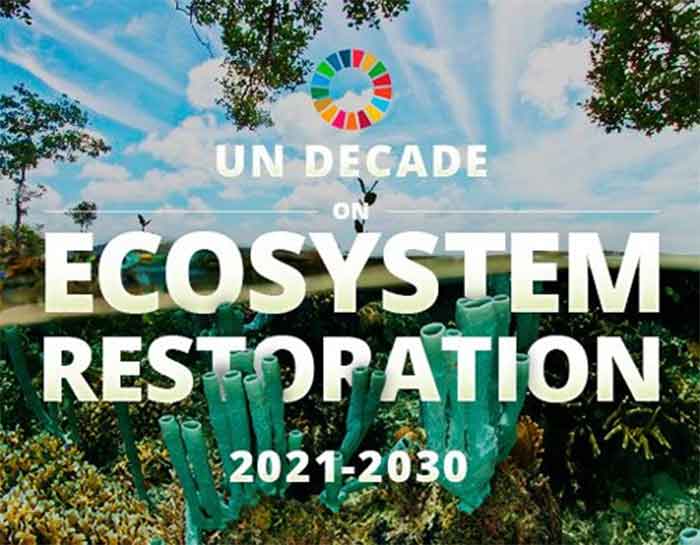
“The future of humanity and indeed, all life on earth, now depends on us.”
— David Attenborough (Biologist, broadcaster and writer)
On January 6, 2025, a catastrophic incident occurred in the Dima Hasao district of Assam, where nine miners became trapped in an illegal rat-hole coal mine near Umrangso. The mine flooded when water from an adjacent abandoned mine gushed in, leading to a prolonged and challenging rescue operation. Despite efforts by the National Disaster Response Force and other agencies, all nine miners tragically lost their lives. This disaster highlighted the persistent issue of illegal mining in the region, which not only endangered human lives but also caused significant environmental degradation.
Restoring ecosystems is not just an environmental imperative today, it is a necessity for basic survival. Imagine a world where degraded landscapes bloom back to life, water bodies sparkle with purity, and wildlife thrives alongside human communities. This vision isn’t a distant dream but a tangible goal achievable through dedicated restoration efforts. Be it the restoration of wetlands in the UK through the work of beavers or the Ganges River rejuvenation project in India, the reconversion of ecosystems has set significant examples for rejuvenating our Mother Earth. But that doesn’t suffice! In this rapid world of global modernisation, with rising climate challenges and biodiversity loss, the urgent need to restore ecosystems becomes ever more apparent, paving the way for a harmonious, safe and sustainable future.
But what really is an ecosystem and why conserving it is important ?
An ecosystem refers to a dynamic community of living organisms interacting with their physical environment on a regular basis. This intricate web of life supports our everyday essential processes like nutrient cycling, water purification, temperature monitoring and climate regulation. When this same ecosystem is consistent in natural processing, it is then called a sustainable environment. This means that it is capable of sustaining itself and reproducing, referring to a healthy environment . Now the concept of conserving ecosystems is crucial for this sustainable development to exist because throughout the years , we humans have interfered with nature’s produce in the name of development. Today, this has not just led to scarcity of basic resources but the unsurety of renewability is still a question on our part. The destruction of ecosystems over the decades has led to severe environmental and socio-economic consequences. Deforestation and habitat loss have accelerated species extinction, with nearly 1 million species at risk (IPBES, 2019). Soil degradation affects 52% of global agricultural land, reducing food production (FAO, 2021). The loss of wetlands and forests has worsened climate change impacts, increasing floods, droughts, and extreme weather events (IPCC, 2023).
Though with the difficulties, various initiatives were taken around the globe to amend and mitigate this impact of destructive ecosystems to align with its environment protection goals as well as Sustainable Development Goals . The United Nations’ declaration of 2021-2030 as the Decade of Ecosystem Restoration strikes as a reminder to set our targets straight.
One of the recent positive developments is that in Srinagar. After nearly four decades of pollution and neglect, Khushal Sar Lake in the Himalayas has been restored to its former glory, now serving as a habitat for thousands of migratory birds. Once a vital resource for the city of Srinagar, providing connectivity and livelihoods, the lake had become a dumping ground for waste. However, a community effort, supported by local administration, has revived the lake, delighting its residents.
Another visionary initiative by the government department in Assam where Agence Française de Développement (AFD), launched the Assam Project on Forest and Biodiversity Conservation (APFBC) where it aims to enhance the state’s green cover, promote coexistence between wildlife and humans and increase the resilience of forest landscapes with its communities .To maximize the impact of its efforts and contribute to the Sustainable Development Goals outlined in Agenda 2030, APFBC has adopted an inclusive approach to conservation.
Although some of the success stories have been impressive , the significant gaps and challenges still remain in linking ecosystem restoration to sustainable development.
- First and foremost the planning of long-term policies and efforts to influence its implementation backing with ultimate success of restoration activities is essential to reach out wider audiences.
- Secondly, the adaptability of new technologies are extremely important for ecosystem restoration, particularly in harsh environments such as mining areas, drylands, alpine regions, and polluted areas. For example, the use of drone technology in remote areas can facilitate assisted regeneration through aerial seeding while also monitoring vegetation recovery at the patch level.
- Last but not the least , promotion of initiatives like ‘ Blue Carbon Ecosystem’ on a greater scale where it offers a natural solution to remove carbon from the atmosphere, build resilience to mounting climate change impacts. Another great initiative is the ‘Miyawaki method’ which must be well established. It is a technique pioneered by Japanese botanist Akira Miyawaki, that helps build dense, native forests. The approach is supposed to ensure that plant growth is 10 times faster and the resulting plantation is 30 times denser than usual.
Though various nations and individuals have initiated efforts to improve our environment and aims to curate further, achieving meaningful change requires an inclusive approach. No state policy can function adequately if people like you and me do not join hands and work together. With the constant growth of population and the growing demand of vegetation , the global temperature too has risen above than it should . The temperature has been increasing 0.06° Celsius per decade since 1850 . 2024 was already considered to be the hottest year but with the records of 52.9 degrees in places like Delhi , 2025 might cross the bar . All these are clear examples of devastating ecosystems . If global temperatures continue to rise like this, widespread droughts will devastate agricultural lands, leading to severe food shortages. Forests will succumb to massive wildfires, destroying homes and habitats. Coastal cities will face frequent and intense storms, causing catastrophic flooding and displacing millions of people. Economies will struggle to cope with these disasters, resulting in widespread instability and hardship. Without adequate resources, communities will be left vulnerable, facing hunger and displacement.
Subscribe to Our Newsletter
Get the latest CounterCurrents updates delivered straight to your inbox.
At this rate what will be left for us and the future generations then ? As humans with advanced cognitive skills and multifunctional abilities, we have done more to destroy our ecosystem than to protect it, also causing the destruction of habitats for other species. It’s time to re-conserve our environment and ensure more forests be preserved, and trees be planted throughout the country, particularly in deforested areas. People should be well aware of the dangers of the increasing population and should take precautions to protect the environment, educating them should be our responsibility and as Robert Swan says “The greatest threat to our planet is the belief that someone else will save it.” So let’s not wait !
Priyakshi Gogoi is an independent writer and a research scholar focusing on environmental conservation and ecosystem restoration, particularly in rural India.











































